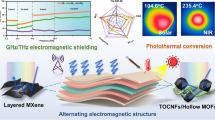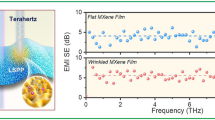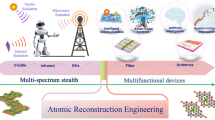Abstract
Two types of resonance absorbers, i.e., Salisbury screens and Jaumann absorbers are systematically investigated in solar radiation absorption. Salisbury screen is a metal-dielectric-metal structure which overcomes the drawback of bulky thickness for solar spectrum. Such structures have a good spectral selective absorption property, which is also insensitive to incident angles and polarizations. To further broaden absorption bandwidth, more metal and dielectric films are taken in the structure to form Jaumann absorbers. To design optimized structural parameters, the admittance matching equations have been derived in this paper to give good initial structures, which are valuable for the following optimization. Moreover, the analysis of admittance loci has been conducted to directly show the effect of each layer on the spectral absorptivity, and then the effect of thin films is well understood. Since the fabrication of these layered absorbers is much easier than that of other nanostructured absorbers, Salisbury screen and Jaumann absorbers have a great potential in large-area applications.
Similar content being viewed by others
References
Bao H, Ruan X. Absorption spectra and electron-vibration coupling of Ti: Sapphire from first principles. Journal of Heat Transfer, 2016, 138(4): 042702
Landy N I, Sajuyigbe S, Mock J J, Smith D R, Padilla W J. Perfect metamaterial absorber. Physical Review Letters, 2008, 100(20): 207402
Atwater H A, Polman A. Plasmonics for improved photovoltaic devices. Nature Materials, 2010, 9(3): 205–213
Wang L P, Zhang Z M. Wavelength-selective and diffuse emitter enhanced by magnetic polaritons for thermophotovoltaics. Applied Physics Letters, 2012, 100(6): 063902
Wang H, Wang L. Perfect selective metamaterial solar absorbers. Optics Express, 2013, 21 Suppl 6(22): A1078–A1093
Fang X, Zhao C Y, Bao H. Radiative behaviors of crystalline silicon nanowire and nanohole arrays for photovoltaic applications. Journal of Quantitative Spectroscopy & Radiative Transfer, 2014, 133(2): 579–588
Fang X, Lou M, Bao H, Zhao C Y. Thin films with disordered nanohole patterns for solar radiation absorbers. Journal of Quantitative Spectroscopy & Radiative Transfer, 2015, 158: 145–153
Feng R, Qiu J, Cao Y, Liu L, Ding W, Chen L. Wide-angle and polarization independent perfect absorber based on one-dimensional fabrication-tolerant stacked array. Optics Express, 2015, 23(16): 21023–21031
Bai Y, Zhao L, Ju D, Jiang Y, Liu L. Wide-angle, polarizationindependent and dual-band infrared perfect absorber based on L-shaped metamaterial. Optics Express, 2015, 23(7): 8670–8680
Hadley L N, Dennison D M. Reflection and transmission interference filters part I. theory. Journal of the Optical Society of America, 1947, 37(6): 451–465
Hadley L N, Dennison D M. Reflection and transmission interference filters part II. experimental, comparison with theory, results. Journal of the Optical Society of America, 1948, 38(6): 483–496
Phillip R W, Bleikolm A F. Optical coatings for document security. Applied Optics, 1996, 35(28): 5529–5534
Berning P H, Turner A F. Induced transmission in absorbing films applied to band pass filter design. Journal of the Optical Society of America, 1957, 47(3): 230–239
Kats M A, Blanchard R, Genevet P, Capasso F. Nanometre optical coatings based on strong interference effects in highly absorbing media. Nature Materials, 2013, 12(1): 20–24
Wang Z, Luk T S, Tan Y, Ji D, Zhou M, Gan Q, Yu Z F. Tunnelingenabled spectrally selective thermal emitter based on flat metallic films. Applied Physics Letters, 2015, 106(10): 101104
Lee B J, Zhang Z M. Design and fabrication of planar multilayer structures with coherent thermal emission characteristics. Journal of Applied Physics, 2006, 100(6): 063529
Wang L, Lee B, Wang X, Zhang Z. Spatial and temporal coherence of thermal radiation in asymmetric Fabry-Perot resonance cavities. International Journal of Heat and Mass Transfer, 2015, 52(13): 3024–3031
Wang L P, Basu S, Zhang Z M. Direct measurement of thermal emission from a Fabry-Perot cavity resonator. Journal of Heat Transfer, 2012, 134(7): 072701
Narayanaswamy A, Chen G. Thermal emission control with onedimensional metallodielectric photonic crystals. Physical Review B: Condensed Matter, 2004, 70(12): 125101
Kats M A, Sharma D, Lin J, Genevet P, Blanchard R, Yang Z, Qazilbash M M, Basov D N, Ramanathan S, Capasso F. Ultra-thin perfect absorber employing a tunable phase change material. Applied Physics Letters, 2012, 101(22): 221101
Shu S, Li Z, Li Y Y. Triple-layer Fabry-Perot absorber with nearperfect absorption in visible and near-infrared regime. Optics Express, 2013, 21(21): 25307–25315
Li Z, Palacios E, Butun S, Kocer H, Aydin K. Omnidirectional, broadband light absorption using large-area, ultrathin lossy metallic film coatings. Scientific Reports, 2015, 5(1): 15137
Kocer H, Butun S, Li Z, Aydin K. Reduced near-infrared absorption using ultra-thin lossy metals in Fabry-Perot cavities. Scientific Reports, 2015, 5(1): 8157
Li Z, Butun S, Aydin K. Large-area, lithography-free super absorbers and color filters at visible frequencies using ultrathin metallic films. ACS Photonics, 2015, 2(2): 183–188
Yan M. Metal-insulator-metal light absorber: a continuous structure. Journal of Optics, 2013, 15(2): 025006
You J B, Lee W J, Won D, Yu K. Multiband perfect absorbers using metal-dielectric films with optically dense medium for angle and polarization insensitive operation. Optics Express, 2014, 22(7): 8339–8348
Brahmachari K, Ray M. Performance of admittance loci based design of plasmonic sensor at infrared wavelength. Optical Engineering, 2013, 52(8): 087112
Brahmachari K, Ray M. Admittance loci based design of a nanobioplasmonic sensor and its performance analysis. Sensors and Actuators. B: Chemical, 2015, 208: 283–290
Badsha M A, Jun Y C, Hwangbo C K. Admittance matching analysis of perfect absorption in unpatterned thin films. Optics Communications, 2014, 332(4): 206–213
Palik E D. Handbook of Optical Constants of Solids. San Diego, CA: Academic Press, 1985
MacLeod H A. Thin-film Optical Filters. Boca Raton: CRC Press, 2017
Fang X, Zhao C Y. Unified analyses and optimization for achieving perfect absorption of layered absorbers with ultrathin films. International Journal of Heat and Mass Transfer, 2017, 111: 1098–1106
Watjen J I, Bright T J, Zhang Z M, Muratore C, Voevodin A A. Spectral radiative properties of tungsten thin films in the infrared. International Journal of Heat and Mass Transfer, 2013, 61(6): 106–113
Acknowledgements
This work was supported by Shanghai Key Fundamental Research (Grant No. 16JC1403200), National Natural Science Foundation of China (Grant Nos. 51636004 and 51476097).
Author information
Authors and Affiliations
Corresponding author
Rights and permissions
About this article
Cite this article
Fang, X., Zhao, C.Y. & Bao, H. Design and analysis of Salisbury screens and Jaumann absorbers for solar radiation absorption. Front. Energy 12, 158–168 (2018). https://doi.org/10.1007/s11708-018-0542-6
Received:
Accepted:
Published:
Issue Date:
DOI: https://doi.org/10.1007/s11708-018-0542-6




